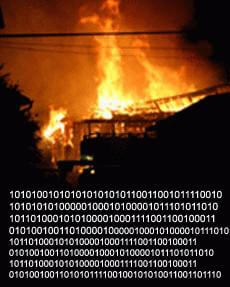
Readily available information and communications systems systems could greatly enhance rescue and rapid response: specialized sophisticated applications especially created for emergency response purposes could do much more, a new National Research Council Report finds.
The 2-year study by IT experts, including ISI division directors Yigal Arens and Robert Neches, finds that digital computing and communication devices have large unused potential that could save lives and protect property in disasters like earthquakes, floods, hurricanes or terrorist attack.The 176-page report, released January 22, includes 10 specific recommendations, both for “low-hanging fruit”- easy and economical steps using existing off-the-shelf technology – as well as more ambitious plans for creating new specialized IT-Emergency applications.
The report also includes detailed rehearsals of existing response capabilities to three fictional, but realistic disasters, including a chemical weapons attack in Washington D.C. on the Metro; a category 4 hurricane coming ashore in the Tampa, FL area, and a magnitude 7.3 earthquake striking near San Francisco on the Hayward fault in the middle of the night.
These reconstructions, based on existing resources and practices and assuming best use of those resources by officials, reveal large potential benefits from relatively simple improvements and enhancements in IT systems, either putting new ones in place, or making better use of what is now there. Examples:
The chemical attack: “A striking aspect of the response described is the need to rapidly gather and disseminate information in order to create sufficient situation awareness for making effective response decisions in a rapidly evolving situation. For instance, chemical sensors started going off only 40 seconds after the initial report of a casualty-and yet this was already too late to avoid dispatching responders and keep doors from opening on entering trains. Detection of harmful agents might, for instance, trigger automated response systems to halt or reroute the entry of further trains coming into the area.”
The hurricane: “While transportation officials are able to identify traffic congestion using cameras and communicate problems that have already developed, use of traffic sensors that measure speed and volume of traffic could be incorporated with information about infrastructure damage and other situational variables into decision support systems to proactively recommend alternate routes before the transportation system bogs down. Civilian volunteers at homes and shelters, fire departments, and police stations maintain could be pre- equipped with WiFi network capability, and designated as an integral information source in emergency plans. Civilians in the damaged areas with functioning IT systems (e.g. cell phones) could have a channel for sending pictures and other information from areas to a designated repository which can be used to build situation awareness. With technology available and on the horizon it is possible to imagine rescue teams, as they drive into designated areas, receiving constant updates from DOT recon teams on road conditions and damage. A road map on a responder laptops glows with red overlays on known or suspected damaged bridges. Navigation software attempts to create directions for each of teams that will get them to their assigned grid. As they drive in, a team member uses infra-red and laser cameras to video-record the geolocated damage. As a team passes a WiFi hot spot, the laptop downloads new information from flyovers and the weather service and transmits video to the incident commander on a priority basis and then to the EOC. Decision support tools could begin combing emerging information, correlating and analyzing who needs what kind of help and transportation conditions. They could also identify areas where no information is available and target quick recon teams to check out those blind spots.
The earthquake: The dependence on models for rapid initial deployment is an especially striking aspect of this scenario. Aggregating the status information from the FEMA, Red Cross, DHHS, and DOD logistics and human resource systems is particularly difficult. Without a significant level of confidence in this information, managers cannot be sure they know what impacts have occurred, what resources are needed, or what resources are responding. Models may also be valuable to responders and other on- thescene personnel who may gain insights because of their perspective that more distant emergency managers may not pick up. However, this level of sharing is typically not done. A way to push access to modeling systems to more people- who could also “play with” the models-may yield significant benefits. Also, modeling results is often not shared with lower level personnel, though they may be able to act more efficiently if it were.
The 15-member Committee on Using Information Technology to Enhance Disaster Management, chaired by Ramesh R. Rao of the University of California, San Diego, wrote the report, which was in preparation when Hurricane Katrina hit New Orleans.
“The tragic events in Katrina’s wake,” writes Dr. Rao, in the preface to the study, “have served to underscore the importance of disaster management; the interplay between technical and organizational considerations, and the contribution that research and development in these areas could make to future disaster management activities.”
The committee included members not only from academia but also law enforcement, municipal government, and the private sector, and was under the overall direction of Jon Eisenberg, director of the Computer Science and Telecommunications Board of the National Academies. Andrew J. Viterbi, namesake of the USC Viterbi School of Engineering, is a member of the CSTB.
The 10 recommendations are aimed at bolstering six “capabilities,” seen as crucial to emergency response. These include:
1. More robust, interoperable, and priority-sensitive communications
2. Improved situational awareness and a common operating picture
3. Improved decision support and resource tracking and allocation
4. Greater organizational agility for disaster management
5. Better engagement public
6. Enhanced infrastructure survivability and continuity of societal functions
For each of the capabilities, short-, mid-, and long-term measures are proposed that would improve them.
The organizational, financial and IT problems of acquiring these improved capabilities are not trivial, the study group found, and the report includes an extensive catalog of what the difficulties are, and ways to overcome them.
Finally, the report outlines a research agenda for developing the new tools it sees as most necessary, together with a recommended roadmapping process for fleshing out and refining the research agenda.
Yigal Arens and Robert Neches are both division directors at ISI, leading the Intelligent Systems and Distributed Scalable Systems divisions respectively..
The report, “Improving Disaster Management: The Role of IT in Mitigation, Preparedness, Response and Recovery” is available from the National Research Council website at http://www.nap.edu/catalog/11824.html
Published on January 23rd, 2007
Last updated on August 6th, 2021












